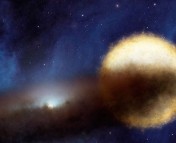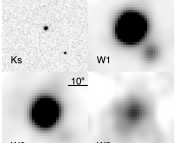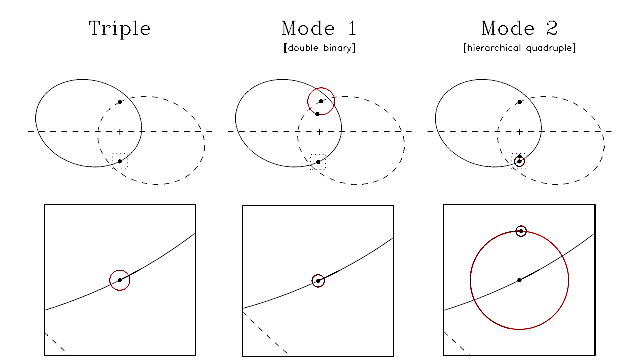This guest post was written by Yuchen Xing, a graduate student at Nanjing University studying high mass star formation, in conjunction with an assignment in the Astronomical Literature Reading and Writing class taught by Professor Zhi-Yu Zhang. In addition to her research, anything about compact stars is also in her interest. When not working, you can find her lying around like a salty fish or collecting shiny little gemstones on nearby volcanoes.
________________________________________________________________________________________________________
Title: A pulsating white dwarf in an eclipsing binary
Authors: Steven G. Parsons, Alexander J. Brown, Stuart P. Littlefair, Vikram S. Dhillon, Thomas R. Marsh, J. J. Hermes, Alina G. Istrate, Elme Breedt, Martin J. Dyer, Matthew J. Green, and David I. Sahman
First Author’s Institution: University of Sheffield, UK
Status: Accepted for publication in Nature Astronomy, open access on arXiv
The problem of core composition
White Dwarfs (WDs) are the remnants of low-mass and average mass stars. They are the end point of 97% of the stars in our galaxy. WDs can be divided into three main groups based on their core composition: oxygen-neon WDs, carbon-oxygen WDs, and helium WDs. The chemical composition of a WD is based on what type of star it came from and how it evolved. For single WDs and WDs in binary systems without mass-transfer, the core composition can be inferred from the mass of the stars they have evolved from. Those WDs that have evolved from stars with lower mass have cores composed primarily of carbon and oxygen, while those which have evolved from stars with higher mass have cores that contain heavier elements like neon and magnesium.
When it comes to WDs interacting in a binary system where mass transfer is involved, things get more complicated. For a pre-WD whose companion is a red giant star or on the asymptotic giant branch (AGB), the WD may accrete hydrogen/helium-rich material and evolve into a very low mass (< 0.45 M☉) WD. Those very low mass WDs can have either helium cores or hybrid (composed of both carbon-oxygen and helium) cores. So, for low mass WDs in binary systems, core composition of helium, carbon-oxygen and hybrid are all expected.
In today’s paper, with the discovery of the first known pulsating WD in an eclipsing binary, the authors find a new method in studying the core composition of WDs.
Get to know SDSS J1152+0248
Discovered in 2015 by the Kepler K2 Mission, SDSS J115219.99+024814.4 (hereafter SDSS J1152+0248) is an eclipsing double WD system. The eclipses can be seen in the change of the system’s brightness with time, namely in light curves. The two WDs move in their orbits, obscure each other’s light with a period of about 2.4 hours, making light curves of the system change periodically.
In addition to eclipses, pulsations of WDs can also be reflected in light curves. Pulsations of WDs are caused by oscillation and the change of state during cooling of WDs. All WDs go through at least one phase of pulsations along their evolution. The authors of today’s paper discovered pulsations of the cooler WD of SDSS J1152+0248, which show up as brightness fluctuations in light curves, making it the first known pulsating WD in an eclipsing binary system.
The light curves used in the paper were obtained with the HiPERCAM camera on the Gran Telescopio Canarias (GTC), one of the largest optical telescopes in the world. The light curves are determined by not only the eclipses of the two WDs, but also pulsations from the cooler component. After subtracting the eclipse drops from the light curves, the authors get Figure 1, in which pulsations with periods of 1314, 1069 and 583 seconds are indicated by the periodic curves.
In order to calculate masses and radii of the WDs, the authors fitted spectra obtained from X-shooter echelle spectrograph on the Very Large Telescope (VLT). Due to Doppler redshift, the wavelengths of spectral lines in the spectra provide radial-velocity information of the two WDs. Those velocities are used in the calculation of eclipsing timescales, which are necessary for the fitting of light curves and the subsequent calculation of masses and radii. The pulsations of the cooler WD, as a component affecting the eclipse profiles, allow the authors to constrain the radii of both WDs better.
The hotter white dwarf of the pair has a mass of 0.362 M☉ and a radius of 0.0212 R☉ while the cooler has a mass of 0.325 M☉ and a radius of 0.0191 R☉ . The masses and radii are model independent, which means they can be compared with theoretical mass-radius relationships to obtain information of the WDs’ internal composition. Figure 2 shows the masses and radii of the WDs along with four structural models, but those properties can be explained by both the helium core and the carbon-oxygen core models.
Core composition of SDSS J1152+0248
The possibility for the WDs in SDSS J1152+0248 to have carbon-oxygen cores is ruled out by comparing their properties with theoretical models. To evolve into carbon-oxygen core WDs with masses lower than 0.5 M☉ , the progenitor stars have to go through the RGB phase and undergo substantial mass loss. However, that path to low-mass carbon-oxygen WDs also restricts age of the systems to roughly 1 Gyr, which is much younger than SDSS J1152+0248.
As a combination of the helium core and the carbon-oxygen core models, WDs with hybrid helium-carbon-oxygen cores can be used to explain the core composition of WDs in SDSS J1152+0248, but the explanation of WDs with helium cores and extremely thin surface hydrogen layers also carries weight. The low masses (0.36 M☉ and 0.33 M☉ ) of the two WDs match with what we can see in helium core WDs, though their radii are 10% smaller than those of helium core WDs according to models. But the problem can be solved with extremely thin surface hydrogen layers. The two assumptions, however, can not be distinguished by mass-radius relation alone for both the helium core and the carbon-oxygen core models are found to be inside the 95% confidence intervals of the WDs’ masses and radii, as we can see in Figure 2.
How can we find the true solution to core composition of the WDs in SDSS J1152+0248? That’s where the importance of pulsations turns up. Considering the pulsations from the cooler WD, the mean period spacing of the eclipsing binary system will be different for the two assumptions. With more light curve data, the core composition of the WDs in SDSS J1152+0248 may finally be revealed and therefore improve our understanding of close binary evolution.
Featured image credit: Caltech/IPAC




